Guest Post by SAJAN VENNIYOOR
“There is no Hindu canon,” declares Wendy Doniger in The Hindus. “The Vedas did not constitute a closed canon, and there was no central temporal or religious authority to enforce a canon had there been one.”
This is a curious argument in defence of heterodoxy. Canons don’t spring fully formed like Athena from the head of Zeus, or drop from the lips of a passing Archangel. Someone has only to do the hard work, and it’s never too late to make a nice hard canon.
As Doniger says, Hinduism as we know it today “is composed of local as well as pan-Indian traditions, oral as well as written traditions, vernacular as well as Sanskrit traditions, and nontextual as well as textual sources.” That’s good news – plenty of material there to choose a canon from.
Back in the 16th century, the Church found itself up the creek without a canon. Plagued by fifteen hundred years of heresies and heterodoxies, disagreements over the sacraments and the scriptures, not to mention a perfect storm of lusty, busty images in Renaissance religious art, the Catholic Church sat in ecumenical council between 1545 and 1563 and decided, once and for all, what was IN and what was OUT.
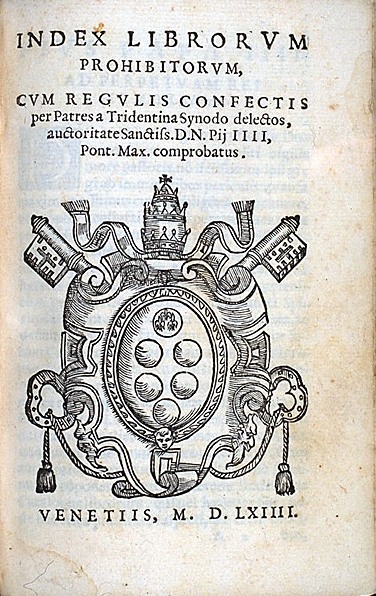
Index of Prohibited Books
It took the Church just over 1500 years – from the crucifixion of its founder to the Council of Trent – to decide which of its written books and unwritten traditions were truly sacred and which were profane (and which were to be banned).
In its final session in 1563, the Council laid down the law on sacred images. These, the Council grudgingly conceded, were beneficial to the illiterate but it decreed that, in the “sacred use of images, all superstition shall be removed, all filthy quest for gain eliminated, and all lasciviousness avoided, so that images shall not be painted and adorned with a seductive charm…”
This brings me to the cover of Doniger’s The Hindus, on which “Lord Krishna is shown sitting on buttocks of a naked woman surrounded by other naked women.” The question which troubles all right-thinking Hindus, as it did the good men of the Church, is whether it is lawful or even in good taste to depict the Lord and his saints in a manner ill suited to polite society.
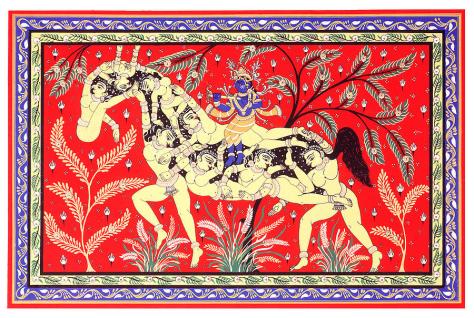 Krishna with gopis – composite image
Krishna with gopis – composite image
Did the NOTICEE wantonly indulge “in unlawful act by showing photograph of Hindu God sitting on the lap of a naked woman & surrounded by naked women”? India has a long and dismal tradition of showing images of gods (and angels, and demons and kings) sitting on the buttocks of naked women. It is one of those kinky traditions that has persisted down the ages, at least from the 17th century CE. The Persians are to blame, of course, but once the Mughals brought these composite images into India, the Hindus embraced the style with a deplorable enthusiasm. They painted naked women by the score, in knots, in arches, in chariots and palanquins, often shaped into horses and elephants, more often than not with a gent sitting on the buttocks.

Composite Animal
Arguments from tradition are absurd. Are we supposed to tolerate licentiousness on this scale just because our ancestors were over-sexed louts who should have known better? This whole business of privileging pornographic images simply because they are very old or have religious origins is suspect. (The Information Technology (Amendment) Act 2008 penalizes the publishing or transmission of “any material which is lascivious or appeals to the prurient interest,” but, it adds reverently, not if they are “kept or used for bona fide heritage or religious purpose”).
It’s no use saying that such images “possibly represent the belief in the internal unity of all beings and illustrate the doctrine of the transmigration of souls through successive reincarnations”. The Shiksha Bachao Andolan may not be au courant with the doctrine of the transmigration of souls, but I’m pretty sure they know souls don’t transmigrate on the backsides of horse-women.
As Dina Nath Batra points out, showing a deity perched in such “a vulgar, base perverse manner” on a woman-horse (nari-ashva) is not only calculated to outrage the religious feelings of Hindus, it is “likely to cause the offence of rioting.” Mr. Batra is 84 years old and if this lewd image can provoke him to riot, there’s no telling what effect it could have on the general populace.
“The rider on the horse is an enduring Hindu metaphor for the mind controlling the senses,” the remorseless Doninger goes on, “in this case harnessing the sexual addiction excited by naked women.”
Enduring metaphor, my ass. Even the horse has a boner.
Doniger, as Shri. Batra has perceptively observed, is hungry of sex. The Hindus: An Alternative History mentions sex 310 times (I counted, twice), far more often than the soul (56) or atman (18). For similarly perverse reasons, Doniger writes about beef twenty-five times – in a book ostensibly about Hindus! – but wholesome vegetables hardly find a mention in her work.
It is evident from the book’s cover picture, and her repeated drooling references to it in the text, that Doniger has a thing about animals. “Three animals—horses, dogs, and cows—are particularly charismatic players in the drama of Hinduism,” she claims with breezy insouciance, and then prattles on about horses (802 references; including gratuitous drivel about mares being the symbol of the evil female, “oversexed, violent, and Fatally Attractive”), and dogs (481) while the cow, that most Hindu of animals, barely clocks in with 258 appearances.
The dog, we know, is as central to the Hindu faith as the platypus is to Semitic religions.
But I digress.
The lewdness of pagan and Renaissance religious art has vexed the faithful down the ages, as students of the genre have noted. Michelangelo’s frescoes are packed wall-to-wall – and right across the ceiling – with nudity and licentiousness.
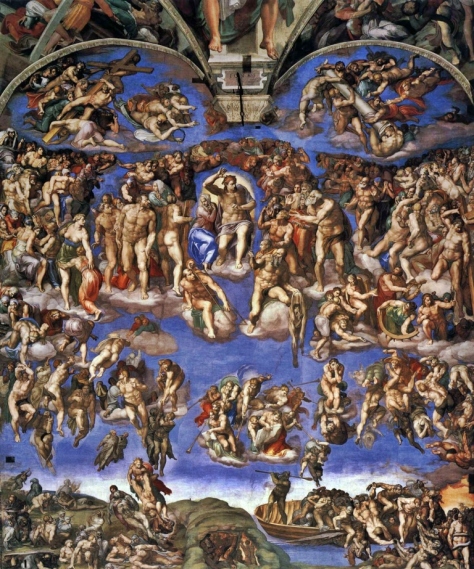
The Last Judgment
Most churchmen were appalled by The Last Judgment. “It was a very disgraceful thing to have made in so honorable a place [i.e, the Sistine Chapel] all those nude figures showing their nakedness so shamelessly, and that it was a work not for the chapel of a Pope, but for a brothel or tavern,” the papal Master of Ceremonies is reported to have said, with admirable restraint.
The paint was hardly dry on The Last Judgment when Council of Trent, shaken to the core by the “spectacle of martyrs and virgins in improper attitudes” inside the Pope’s chapel, issued their decree against lasciviousness in religious art.
On the literary front, the Council struck equally powerful blows in the name of chastity and decorum. By removing the raunchier and more suspect texts from the hitherto loose canon of Christianity and sequestering them, sometimes in the Apocrypha, sometimes in the Index Prhibitorum and occasionally in a bonfire along with the author, the Council cleaned up the canon. This process continued with the Protestant and Reformed Churches. There is no such thing as a single Christian canon.
Today, if the Christian artist wants to sneak a nude or two into his Art, he has to make do with Bathsheba or, if pressed, the nameless Shulamite from the Song of Songs (and I am at a loss to explain how that scandalous poem – “Your lips are like a scarlet thread, and your mouth is lovely / Your two breasts are like two fawns, twins of a gazelle that graze among the lilies” – got into the Bible. No doubt Doniger and her crew will call it an allegory – or an enduring metaphor – symbolic of the union between Christ and the Church or, alternatively, Christ and the individual soul. A likely story. There are artistic interpretations of the Dream of the Shulamite that would cause comment in the Playboy Mansion).
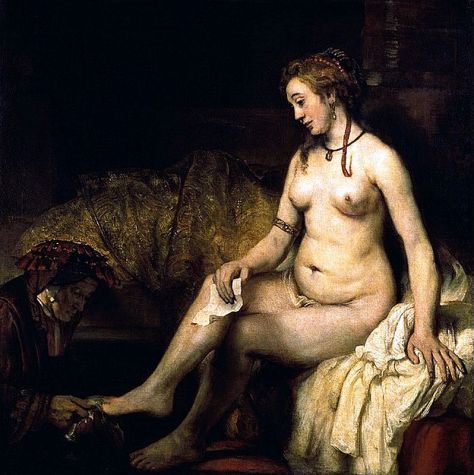
Bathsheba at her bath – Rembrandt
But in the centuries before the Council’s decree, the Christian artist had a smorgasbord of licentiousness to choose from. Michelangelo, in those spacious pre-Tridentine days, had a free hand. He peopled his vast frescoes with martyrs and virgins in improper attitudes and hardly a stitch between them. Take the saints Blaise and Catharine in The Last Judgment. Today, the saintly Catharine, draped in green robes, bends before St. Blaise while the man modestly averts his eyes. It was not always thus. Michelangelo’s muscular Catharine was clothed in nothing but virtue while Blaise gazed at her derriere with pop-eyed fascination. The two, moreover, were presented in an improper attitude that in a later age would be called twerking.
It so disturbed the elders of the Church that they hired an artist to scrape away that part of the fresco and repaint the two saints as we see them today. (This virtuous artist, da Volterra, went on conceal so many of the genitals and bottoms in The Last Judgment with loin cloths and fig leaves that he was dubbed “Il Braghettone” or Daniele, the Breeches-Maker).
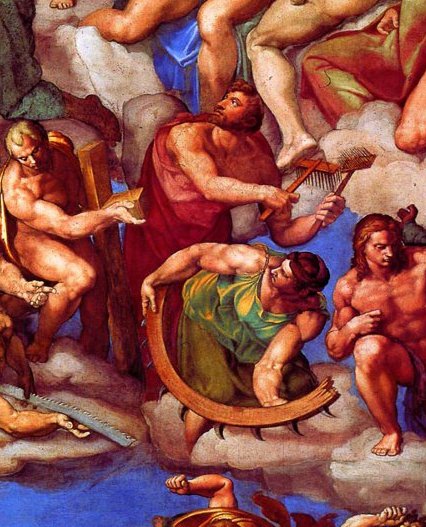
St. Blaise and St. Catharine – from The Last Judgment
Artists, like professors in the University of Chicago, claim to believe that a beautiful body is the physical representation of a beautiful soul. When noted Sanskritist, theologian and painter, Dr. Jose Pereira a.k.a Goa’s Michelangelo, exhibited “nude and derogatory paintings of Hindu Gods” in an exhibition in Goa circa 2010, the Hindu Janajagruti Samiti questioned his motives in language reminiscent of the Shiksha Bachao Andolan’s notice to Doniger. “Instead of painting Hindu Deities in this way, why didn’t Dr Pereira paint Jesus Christ or Mother Mary in the nude?” they asked plaintively. “There are many examples of cruelty towards women in the Bible. Dr Pereira could have painted these pictures to make people aware about his own religion.”
Seriously, what is with these Jewish, Muslim and Christian artists? Can’t they make people aware of their own religions?
Dr. Pereira, quoting chapter and verse from Gita Govindam – in the original Sanskrit – tried to explain that Krishna is the Embodier of Eros (krsna murtiman iva srngara) and that his painting was based on a mural in Padmanabhapuram Palace. Dr. Pereira’s Krsna, clad immodestly in a sketchy yellow garment, “lies in a bower […] attended by five cowgirls, golden brown in color, engaged in intimate love-play with the god.”
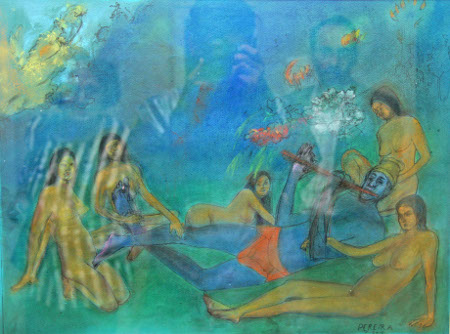
Krsna, Embodier of Eros – Jose Pereira
In the heat of the moment, it did not occur to the Hindu Janajagruti Samiti to inform Dr. Pereira that, in his own Catholic tradition, Embodiers of the Eros, far from dallying with naked cowgirls, are found screaming in the Second Circle of Hell.
Janaki Nair, in these pages, has referred to the “brilliant murals at the Cochin Palace at Mattancherry, where Krishna does not waste a single digital extremity of his eight hands and two feet in pleasing his gopis.”

Krishna with gopis – Mattancherry Palace
The temples and palaces of Kerala are regrettably full of gods and cowgirls in improper attitudes. One is happy to learn from Dr. Nair that the sexually explicit murals in Guruvayur Temple are now being tastefully covered with gold plate.
There is nothing like a little gold plate, or whitewash – or dynamite – to set right the wrongs of the past.
What, then, is an acceptable image of God?
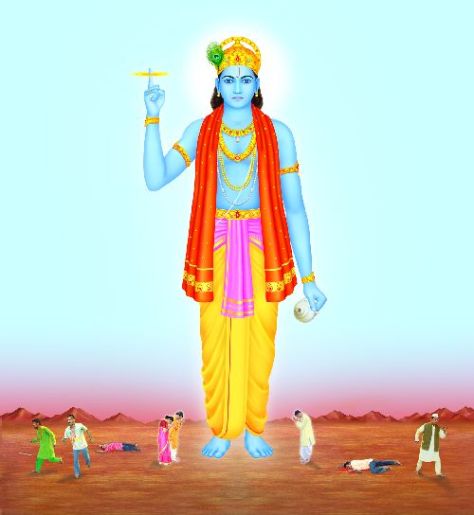
Satvik image of Sri Krishna (Hindu Janajagruti Samiti)
The Sanatan Sanstha has thoughtfully provided a ‘satvik image of Sri Krushna’, based on Spiritual Science, which should please everyone. It depicts the theophany of Krishna as a gigantic figure flanked by dhoti clad devotees. The demonstrably impious, as can be inferred from their green pathani suit, jeans & T-shirt, and kurta and Gandhi-cap, flee in terror. Two enemies of dharma are struck dead – one of them presumably for wearing a purple shirt – and lie bleeding at the Lord’s glowing feet.
Significantly, while there is a female bhakt in the picture, she is modestly clad in a saree and is not being groped (ref. Janaki Nair) nor having her posterior sat upon (vide Wendy Doniger).
All that remains is for us to reform the Hindu canon. From the hundreds, if not thousands of ancient texts that jostle for space in the Hindu library, let’s pick a few good ones. The Vedas and Upanishads would find a place in the Canon, as would some of the Puranas and less controversial bits of the two epics, especially the Bhagavad Gita (though the frumious Doniger mocks it as a book privileged by Euro-Americans and “not always so highly regarded by “all Hindus””, but what does she know?)
Doniger notes with ill-concealed satisfaction that there was no temporal or religious authority to enforce a Hindu canon, but that does not mean there cannot be one now. If the Heads of the Mutts and other Hindu saints were to sit in Council, I am sure they could anthologize, bowdlerize and sacralize a few suitable texts to generate a Hindu canon that would find favour with all right-thinking Hindus.
Surely that would, in the wise words of the Council of Trent, “repress that temerity, by which the words and sentences of sacred Scripture are turned and twisted to all sorts of profane uses, to wit, to things scurrilous, fabulous, vain, to flatteries, detractions, superstitions, impious and diabolical incantations, sorceries, and defamatory libels.” There would be plenty of material left for culture vultures to pick over. Painters like Husain and Pereira and others ‘hungry of sex’ like Doniger can go through the non-scriptural and profane texts and do with it what they will.
If they wish to paint cowgirls entwined in the shape of a camel with a minor forest god sitting on their buttocks, let them do it, I say.

A) The Rig Veda would not find a place in the canon since it refers to an incestuous act between Brahma and his daughter Rohini. Rudra’s arrow facilitates coitus interruptus and the resulting spilt semen falls to the earth and is the beginning of human life.
B) The tenth canto of the Srimad Bhagwat Gita would prevent its inclusion in the canon. It graphically (and poetically) describes sex between Krishna and the gopi during Raas. Poems about lactating women who leave their crying babies when Krishna calls them for Raas in the forests.
LikeLike
The writer asks uncomfortable questions in his extremely-well written piece. But he doesn’t talk about Tantra, an integral part of Hindu consciousness, which’s purely based on uninhibited sex. When a religion allows effing postures and practices through one of its dimensions (read Tantra or occult sciences) and celebrates male-female union and unabashed depiction of it, why then it frowns upon foreigners highlighting the same liberal aspect? But at the same time, I too ask these writers and painters as to why don’t they denude the religious figures and icons of their respective religions?
SUMIT PAUL, Poona
LikeLike
Best piece on this issue yet.
LikeLike
Nice… a refreshingly different perspective…
LikeLike
An unclothed body is the natural state so what on earth is sacrilage about it? To the christian mind yes,
Indian Art is considered complete if it can provide Dharma.artha, kama and moksha to the person experiencing the art. Now what the person decides to take depends on his needs, desire, emotional,mental and spiritual state.
LikeLike
What those who are demanding ‘satvik imagery’ subjected Dr. Jose Pereira’s work to, is almost an exact replay of what they did to the late M F Husain’s work, appraised in the following articles from an art-historical and hermeneutical perspective, as adopted in the above widely researched post.
http://nirmukta.com/2011/06/09/m-f-husain-in-memoriam/
LikeLike
Very nice perspective. Good one.
LikeLike
Fascinating, erudite and so-seriously-tongue-in-cheek that I could not stop thinking and laughing at the same time. Truly a deep meditation on an (almost) impossible conversation. And like some of the best meditations, we come out at least with better knowledge about our own (and some others’) navels…
LikeLike
Batraji will find a nice plan of action here!
LikeLike
@ SAJAN VENNIYOOR, a nice satire but have you wrote anything about death threat issued to Sanal Edamaruku (Edamaruku was forced to seek exile in Finland, according to The Guardian http://www.huffingtonpost.com/2012/11/28/sanal-edamaruku-indian-rationalist-weeping-christ-miracle-hoax-faces-jail_n_2201897.html ) or about denial of censor certificate for ‘Pithavinum Puthranum’ (Pithavinum Puthranum fails to get clearance http://www.newindianexpress.com/entertainment/malayalam/Pithavinum-Puthranum-fails-to-get-clearance/2013/08/19/article1741404.ece#.UxmMzz-Syg4 )
LikeLike
Love it. Just that (not so) poor Batra is 58 and not 85!
LikeLike
This is really interesting. What the author leaves unmentioned that in its quest or anxiety to set up the perfect unimpeachable dogma, the Church also ensured that the ‘dissidents’ were effectively silenced – by way of the Inquisition, the witch-hunts and the burning at the stake of heretics. In the more confused ‘East’, disparate traditions thrived, and so did dissidents.
LikeLike
To be honest, I sympathize with Shri Dina Nath Batra and others like him, whose inchoate anger at what they see as the relentless vilification of their deeply held beliefs finds expression in unfortunate tropes like “Lord Krishna sitting on the buttocks of naked women”. Doniger is fun to read, but Hinduism is a living faith, not an esoteric mythology. By doing textual analyses of a thousand ancient texts in a university library, one can learn everything about Hinduism and understand nothing about being a Hindu. Though I am not one myself, I grew up among devout Hindus and I blinked a bit when I read Doniger on the alarming significance of horses and dogs to Hinduism. One could read the Bible and assume that camels are vital to an understanding of Christianity.
Still, Doniger’s book is titled “An Alternative History”, which some of her critics — and some of her fans — seem to have missed.
Likewise, I’d have assumed that the title of my scholarly essay, “The buttocks of naked women”, betrays the profundity of its contents. @anu kumar, yes, I’m moderately familiar with the Church’s short way with dissidents, the Inquisition, the burning of heretics and the witch-hunts (which, I think, had more complex socio-political triggers than the consolidation of religious dogma in the 16th century). But it is all very depressing, and I was taking a lighthearted look at the forging of canons. Maybe another time…
@Nimi – Batra’s age is a mystery. True, his notice to Doniger and Penguin says he is (or was, in 2010) 58 years old, but several newspaper articles — some quoting his own words like, “I feel 84 years young” — suggest that he is an octogenarian. He looks like an octogenarian. Unless, of course, his battles with the ungodly have prematurely aged him.
@Shama Zaidi – I’m not worried that Batraji will find a plan of action in my immortal words, but I have no doubt that a plan of action to deal with dissidents, heretics, critics and godless liberals is very much on the Hindutva agenda. We have interesting times ahead of us.
LikeLike
Sajan, do you write anywhere else besides Kafila? Would love to read some more of your thoughts.
LikeLike
Well, no. I write very little, and I have an asymmetric romance with Kafila: I send them four or five articles and they publish one. The moderators have an editorial policy graven in some hard, unyielding substance.
LikeLike
That is what blogs are for – who needs kafila? The perspective of the equal offender has been markedly absent in this very interesting academic brawl. If your article could make me laugh while reading it for the second time, you have no right to remain silent!
LikeLike
The lack of a “Hindu” canon is what elevates it above religious philosophies. The big negative is of course that it allows for the proliferation of weirdos and keepers of faith. But the very same aspect allows for the development of a vareity of schools of thought. And one is allowed to pick and choose. In short we can either sink or swim as per our choices. What could be better?
LikeLike
Superb!
LikeLike
ya I support it why don’t we know more about yoni puja
LikeLike
all reigions ate stories to prop up their glory. what is worse in hinduism is discrimination of people which pushed a group down to the ground and below brandished as social blot. it was well felt by ambedkar who was not an ordinary person. please amend hiduism to annihilate caste.
LikeLike